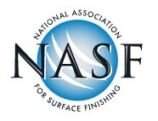The course consists of 9 lessons. Each one contains a wealth of valuable, practical information.
We strongly recommend that learners take the Plating Essentials Course prior to the start of Electroplating & Surface Finishing (CEF) Course.
Course Options
Web-Based
Dates: February 6, 7, 13, 14, 20, 21, 27, 28
Registration Deadline: February 1, 2024
Member: $975 | Non-Member: $1,300Home-Study
Member: $900 | Non-member Tuition: $1,300
Optional Exam
Member: $200 | Non-member Tuition: $300
Who Benefits:
This training program benefits individuals who have no experience or training in the art and science of electroplating. Examples are new hires for plating line work, inexperienced supervisors, sales personnel serving metal finishers, and managers who want a non-technical/low technical primer in the subject. This training is also a valuable introductory course for those who intend to go further with more advanced training.
Goal:
The goal of this course is to provide greater comfort with terminology, knowledge of coating differences and process equipment used in electroplating operations.
- At the conclusion of this course, attendees can expect to:
- Understand the finishes commonly applied by the electroplating process and the basic differences in performance among the various coatings.
- Have a basic level of understanding of math, electricity, chemistry and electrochemistry as it relates to the electroplating process.
- Be able to identify and describe the main components in an electroplating process.
- Know the various types of parts and problems that each can pose when processed by electroplating.
Course Description
- 1. Plating Calculations
- This lesson teaches basic math skills that allow students to understand the concepts of current density and the relationships between current density, plating time and plating quality.
- 2. Introduction: Chemistry, Electricity and Electrochemistry
- This lesson provides a non-technical look at the chemistry involved in the production and operation of electroplating solutions. This lesson will also provide a non-technical look at electricity and electrochemistry, as they relate to the production and operation of electroplating solutions.
- 3. Electroplating Equipment
Students become familiar with the equipment that makes up a plating line and individual plating tanks and their function. The importance of the proper use and maintenance of each of the following equipment is detailed:
- Plating Lines
- Plating Tanks
- Anodes
- Rectifiers and Electrical Connections
- Heating & Cooling
- Filtration & Agitation
- Air Handling & Exhaust
- 4. Rack & Barrel Plating
The basic construction of a plating rack and the importance of each feature is a focus of this lesson. The importance of proper racking methods and the care and maintenance of plating racks is also covered. The use of shields and robbers is another focus of this lesson.
The basic construction of a plating barrel and the importance of proper barrel loading, care and maintenance of barrels are discussed.
- 5. Types of Plated Parts
- Why certain metals or parts require special attention and processing is the main focus of this lesson. Also covered are common plating problems posed by parts made of steel, stainless steel, aluminum, zinc and copper and its alloys.
- 6. Preparing Parts for Plating
- This lesson provides a basic understanding of primary methods employed to prepare parts for plating. Included in this lesson are soak cleaning, electrocleaning, acid pickling, etching and descaling. Why these operations are critical to the quality of the plated parts is the main focus of this lesson.
- 7. Popular Plating Processes
- Students are provided with operational information on common plating processes, including zinc, zinc alloy, decorative nickel, functional nickel, decorative chromium, hard chromium, copper and silver plating.
- 8. Common Plating Defects
- This lesson focuses on the causes, effects and prevention of contamination of the plating solutions covered in lesson 7.
- 9. Stripping
- This lesson focuses on best operating practices for conducting stripping operations.
